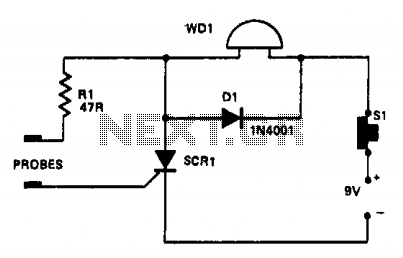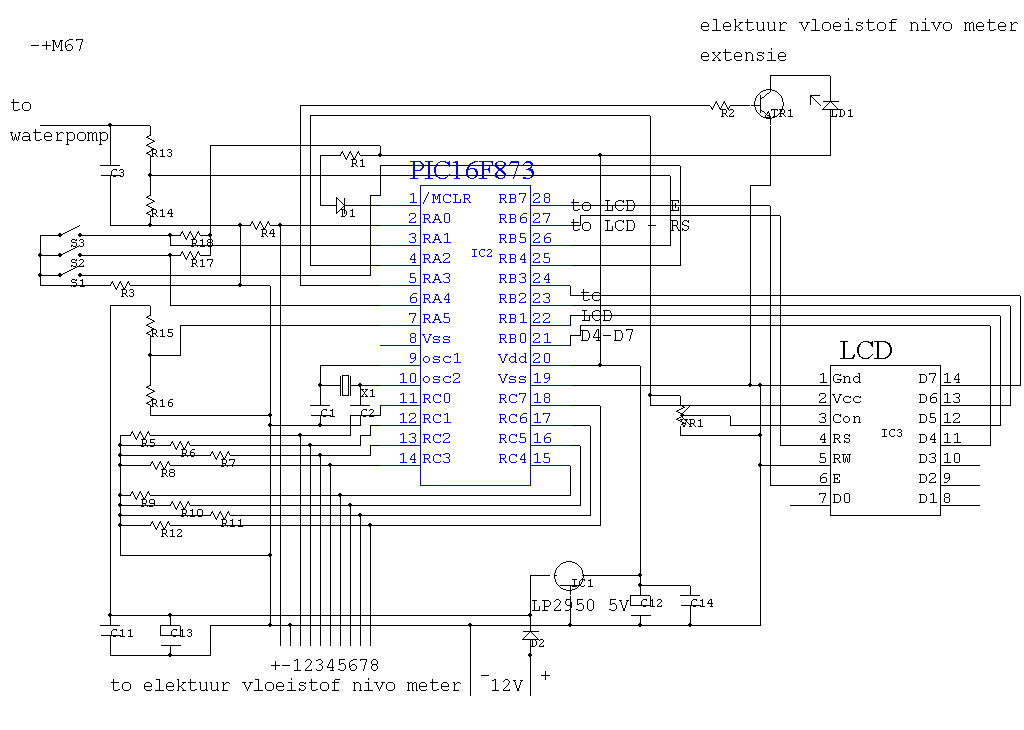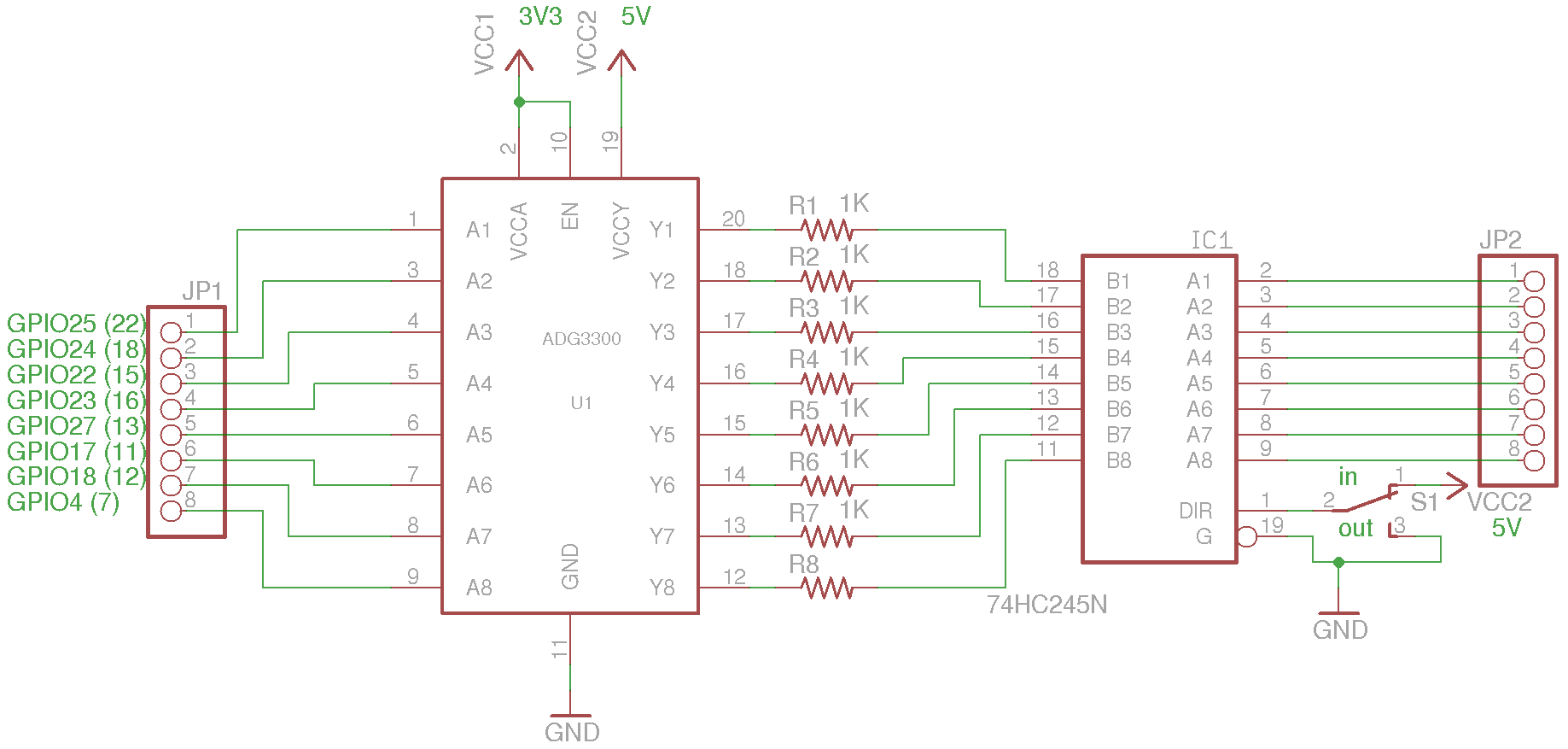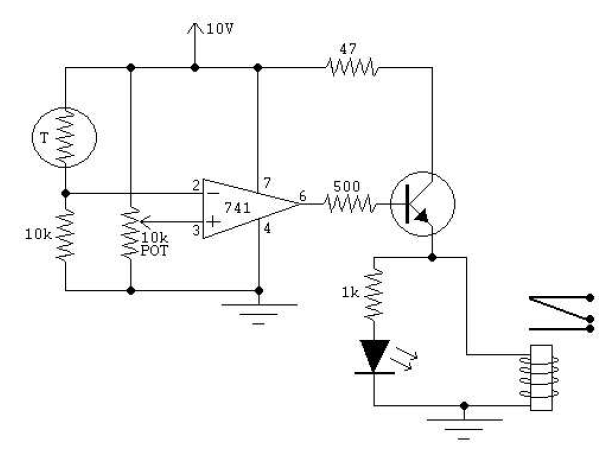
Water Level Alert
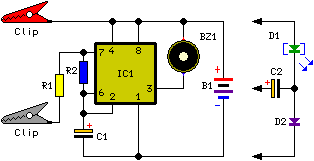
This circuit emits an intermittent beep or flashes an LED when the water level in a container reaches a specified height. It is designed to be mounted on top of the container, such as a plastic tank, using two crocodile clips that also function as probes. For deeper sensing, the clips can be extended with two pieces of stiff wire. The circuit utilizes a 555 CMOS timer chip (IC1) configured as an astable multivibrator, with its operating frequency determined by capacitor C1, resistors R1 and R2, and the resistance created by the water between the probes. When the probes are shorted, the output frequency is approximately 3 Hz, resulting in a beep or flash three times per second. However, since water typically has some resistance, the actual frequency will be lower, resulting in less than one beep or flash per second. As the probes are submerged in water, the resistance decreases, leading to an increase in the oscillation frequency of IC1. This provides a rough audio or visual indication of the water level. If an LED is used for indication, additional components C2, D1, and D2 must be included to double the output voltage for proper LED function. Notably, the circuit operates on a 5V supply with ultra-low current consumption: 40 µA in standby mode and 0.5 mA during operation, allowing a single AAA alkaline battery to last several years and eliminating the need for a power on/off switch.
The circuit design incorporates a 555 timer in astable mode, which continuously oscillates between high and low outputs, creating a square wave signal. The frequency of oscillation is influenced by the resistive path created by the water, which alters the timing interval of the output. The configuration of resistors R1 and R2, along with capacitor C1, sets the base frequency, while the water resistance fine-tunes the output.
When the water level reaches the probes, the resistance decreases, leading to a higher frequency output from the 555 timer. This change in frequency can be heard as an increasing beep rate or observed as a faster LED flash, providing immediate feedback on the water level. The integration of diodes D1 and D2 in the circuit ensures that the LED receives sufficient voltage to operate effectively, allowing for clear visual indication.
The circuit's low power requirements are particularly advantageous for long-term applications, as it minimizes battery drain. The choice of a 5V supply voltage makes it compatible with standard battery types, while the design's simplicity allows for easy assembly and maintenance. The use of crocodile clips as probes not only simplifies installation but also enhances the circuit's versatility, enabling it to be adapted to various container sizes and types.
Overall, this water level sensing circuit is an effective solution for monitoring fluid levels in diverse applications, providing both auditory and visual alerts with minimal power consumption.This circuit will emit an intermittent beep (or will flash a LED) when the water contained into a recipient has reached the desired level. It should be mounted on top of the recipient (e. g. a plastic tank) by means of two crocodile clips, acting also as probes. If a deeper sensing level is needed, the clips can be extended by means of two pieces o f stiff wire (see pictures). IC1, a 555 CMos timer chip, is wired as an astable multivibrator whose operating frequency is set by C1, R1 and R2, plus the resistance presented by water across the probes. If the resistance across the probes is zero (i. e. probes shorted), the output frequency will be about 3Hz and the sounder will beep (or the LED will flash) about three times per second.
As water usually presents a certain amount of resistance, the actual oscillation frequency will be lower: less than one beep/flash per second. As probes will be increasingly immersed in water, the resistance across them will decrease and the oscillation frequency of IC1 will increase.
This means that a rough aural or visual indication of the level reached by water will be available. If a LED is chosen as the alert, C2, D1 and D2 must be added to the circuit in order to double the output voltage, thus allowing proper LED operation (see the rightmost part of the schematics). Interesting features of this circuit are 1. 5V supply and ultra-low current consumption: 40 µA in stand-by and 0. 5mA in operation. This allows a single AAA alkaline cell to last several years and the saving of the power on/off switch.
🔗 External reference
The circuit design incorporates a 555 timer in astable mode, which continuously oscillates between high and low outputs, creating a square wave signal. The frequency of oscillation is influenced by the resistive path created by the water, which alters the timing interval of the output. The configuration of resistors R1 and R2, along with capacitor C1, sets the base frequency, while the water resistance fine-tunes the output.
When the water level reaches the probes, the resistance decreases, leading to a higher frequency output from the 555 timer. This change in frequency can be heard as an increasing beep rate or observed as a faster LED flash, providing immediate feedback on the water level. The integration of diodes D1 and D2 in the circuit ensures that the LED receives sufficient voltage to operate effectively, allowing for clear visual indication.
The circuit's low power requirements are particularly advantageous for long-term applications, as it minimizes battery drain. The choice of a 5V supply voltage makes it compatible with standard battery types, while the design's simplicity allows for easy assembly and maintenance. The use of crocodile clips as probes not only simplifies installation but also enhances the circuit's versatility, enabling it to be adapted to various container sizes and types.
Overall, this water level sensing circuit is an effective solution for monitoring fluid levels in diverse applications, providing both auditory and visual alerts with minimal power consumption.This circuit will emit an intermittent beep (or will flash a LED) when the water contained into a recipient has reached the desired level. It should be mounted on top of the recipient (e. g. a plastic tank) by means of two crocodile clips, acting also as probes. If a deeper sensing level is needed, the clips can be extended by means of two pieces o f stiff wire (see pictures). IC1, a 555 CMos timer chip, is wired as an astable multivibrator whose operating frequency is set by C1, R1 and R2, plus the resistance presented by water across the probes. If the resistance across the probes is zero (i. e. probes shorted), the output frequency will be about 3Hz and the sounder will beep (or the LED will flash) about three times per second.
As water usually presents a certain amount of resistance, the actual oscillation frequency will be lower: less than one beep/flash per second. As probes will be increasingly immersed in water, the resistance across them will decrease and the oscillation frequency of IC1 will increase.
This means that a rough aural or visual indication of the level reached by water will be available. If a LED is chosen as the alert, C2, D1 and D2 must be added to the circuit in order to double the output voltage, thus allowing proper LED operation (see the rightmost part of the schematics). Interesting features of this circuit are 1. 5V supply and ultra-low current consumption: 40 µA in stand-by and 0. 5mA in operation. This allows a single AAA alkaline cell to last several years and the saving of the power on/off switch.
🔗 External reference
